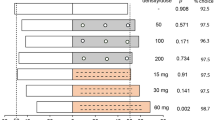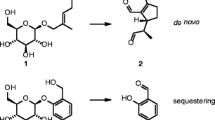Abstract
Nymphs of the cercopid Aphrophora cribrata cover themselves with a frothy exudate while ingesting sap from their preferred host plant, the eastern white pine, Pinus strobus. Chemical analyses of froth collected from A. cribrata nymphs revealed an array of metabolites belonging to five chemical classes, including fatty acid-derived alcohols, γ-lactones and a single 1-monoacylglycerol, as well as the polyol pinitol and the polyhydroxyalkanoate, poly-3-hydroxybutyrate. Bioassays showed the natural A. cribata froth, as well as a synthetic mixture comprised of representative compound classes identified therein, to be repellent to ants but largely devoid of topical irritancy in tests with cockroaches.








Similar content being viewed by others
References
Balaban M, Ucar G (2001) Extractives and structural components in wood and bark of endemic oak Quercus vulcanica Boiss. Holzforschung 55:478–486
Bennett FD (1965) Observations on the role of Clastopteromya spp. Inhabitants of spittle-masses of Clastoptera spp. In: The West Indies Commonwealth Institute of Biological Control and Technical Communications, vol 5, pp 98–100
Blankaart S (1690) Schouburg der Rupsen, Wormen, Maden en Vliegende Dierkens. Lipsing, pp 178
Buckton GB (1890) Monograph of the British Cicadae, or Tettigiidae. Macmilan & Co., London, p 211
Carvalho GS, Webb MD (2005) Cercopid spittle bugs of the new world (Hemiptera, Auchenorrhyncha, Cercopidae). Pensoft Publishers, Sofia, pp 13–16
del Campo ML, Miles CI, Caillaud MC (2009) Effects of experience on the physiology of taste discrimination in insects. In: Newland PL, Cobb M, Marion-Poll F (eds) Insect taste. Taylor & Francis, London, pp 205–242
Eisner T (2003) For love of insects. The Belknap Press of Harvard University Press, Cambridge
Eisner T, Eisner M (2000) Defensive use of a fecal thatch by a beetle larva (Hemisphaerota cyanea). Proc Natl Acad Sci USA 97:2632–2636
Eisner T, Eisner M, Aneshansley DJ, Wu CL, Meinwald J (2000) Chemical defense of the mint plant, Teucrium marum (Labiatae). Chemoecology 10:211–216
Guilbeau B (1908) The origin and formation of the froth in spittle-insects. Am Nat 42:783–798
Hamilton KGA (1982) The insects and arachnids of Canada. Part 10. The spittlebugs of Canada, Homoptera: Cercopidae. Biosystematics Research Institute, Publication 1740, Ottawa, Canada, pp 41–42
Isidorov VA, Rusak M, Szczepaniak L, Witkowski S (2007) Gas chromatographic retention indices of trimethylsilyl derivatives of mono- and diglycerides on capillary columns with non-polar stationary phases. J Chromatogr A 1166:207–211
Kershaw JC (1914) The alimentary canal of a cercopid (Tomaspis saccarina Dist.). Psyche 21:65–72
Lenz RL, Marchessault RH (2005) Bacterial polyesters: biosynthesis, biodegradable plastics and biotechnology. Biomacromolecules 6:1–8
Ley SV, Sternfeld F (1989) Microbial oxidation in synthesis: preparation of (+)- and (−)-Pinitol from Benzene. Tetrahedron 45:3463–3476
Licent E (1912) Recherches d’anatomie et de physiologie compares sur le tube digestif des Homoptères supérieurs. Cellule 28:7–161
Marshall AT (1966a) Spittle production and tube-building by Cercopid larvae (Homoptera)-IV. Mucopolysaccharide associated with spittle production. J Insect Physiol 12:635–644
Marshall AT (1966b) Histochemical studies on a mucocomplex in the malpighian tubules of cercopid larvae. J Insect Physiol 12:925–932
Marshall AT (1973) Protein synthesis and secretion by the malpighian tubules of Cercopoid larvae (Homoptera). J Insect Physiol 19:2317–2326
Marshall AT, Cheung WWK (1975) Ionic balance of Homoptera in relation to feeding site and plant sap composition. Entomol Exp Appl 18:117–120
Mata R, Bye R, Linares E, Marcias M, Rivero-Cruz I, Perez O, Timmermann BN (2003) Phytotoxic compounds from Flourensia cernua. Phytochemistry 64:285–291
Mello MS, Pimentel ER, Yamada AT, Storopoli-Neto A (1987) Compostion and structure of the froth of the spittlebug, Deois sp. Insect Biochem 17:493–502
Nolan V Jr (1956) Spittle insects as food of prairie warblers. Auk 73:557
Pelagatti O, Roversi PF, Baccetti C (1995) Indagini sulla microflora batterica associata alle schiume di Haematoloma dorsatum (Ahrens) (Homoptera, Cercopidae). Redia 78:243–251
Rose AH, Lindquist OH, Nystrom KL (1999) Insects of eastern pines. Canadian Forest Service, Publication 1313, Ottawa, Canada, pp 78–79
Schroeder FC, del Campo ML, Grant JB, Weibel DW, Smedley SR, Bolton KL, Meinwald J, Eisner T (2006) Pinoresinol: a lignol of plant origin serving for defense in a caterpillar. Proc Natl Acad Sci USA 103:15497–15501
Schroeder FC, Taggi AE, Gronquist M, Malik RU, Grant JB, Eisner T, Meinwald J (2008) NMR-spectroscopic screening of spider venom reveals sulfated nucleosides as major components for the brown recluse and related species. Proc Natl Acad Sci USA 105:14283–14287
Whittaker JB (1970) Cercopid spittle as a microhabitat. Oikos 21:59–64
Wilson HA, Dorsey CK (1958) Studies on the composition and microbiology of insect spittle. Ann Entomol Soc Am 50:399–406
Acknowledgments
We thank Dr. Thomas Eisner for helping with the bioassays, and for providing, with Maria Eisner, all of the cercopid photographs. We also thank E. Richard Hoebeke for helping with identification of the A. cribrata nymphs. Dr. Frank Schroeder provided guidance for the NMR analyses. This work was supported by the National Institutes of Health, award #AI02908, Research Corporation award #7813, and a fellowship from Johnson and Johnson.
Author information
Authors and Affiliations
Corresponding author
Rights and permissions
About this article
Cite this article
del Campo, M.L., King, J.T. & Gronquist, M.R. Defensive and chemical characterization of the froth produced by the cercopid Aphrophora cribrata . Chemoecology 21, 1–8 (2011). https://doi.org/10.1007/s00049-010-0059-x
Received:
Accepted:
Published:
Issue Date:
DOI: https://doi.org/10.1007/s00049-010-0059-x




